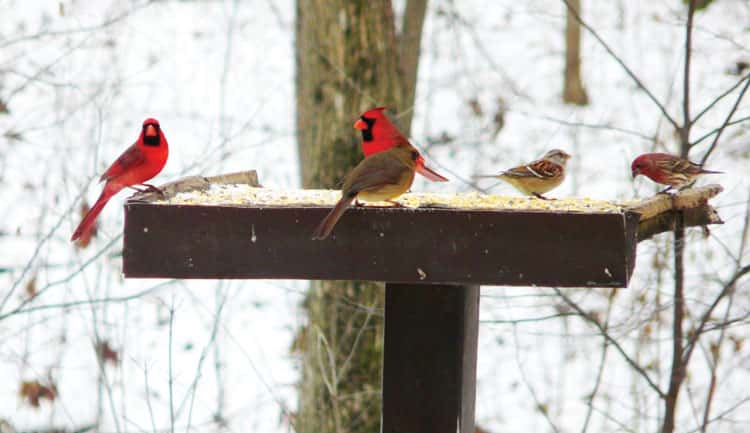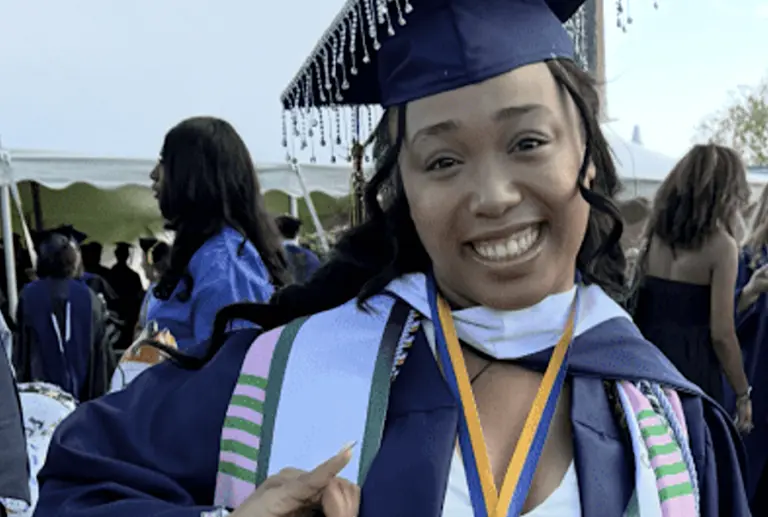

By Anne W. Semmes
Sentinel Correspondent
Follow along Audubon Greenwich Senior Naturalist Ted Gilman if you want to learn how to identify birds in your backyard, especially at this time of year. Gilman walks the walk of a bird, sings the song of a bird, and shows you the size, shape, color, and telltale markings of your backyard birds.
If you were one of the 60-plus aspiring bird counters following Gilman this past Great Backyard Bird Count (GBBC) weekend – he spoke at Grass Island, at Greenwich Library and at the Audubon Center – you’ll know the first spring migratory bird to return was the male red-winged blackbird. “It often arrives on Valentine’s Day,” said Gilman. But, this year it arrived the day after at the Audubon Center.
Rule number one when viewing your backyard birds from inside: “Stand still and play like statues,” said Gilman. “Birds are fearful of movement.”
Beginning birders as young as three-year-old Nina Pizzarello tried on binoculars at an Audubon Center bird-feeding window to view the tufted titmouse, the northern cardinal, and black-capped chickadee. One asked, how does the chickadee survive our winters? “It loses 15% of its body weight from shivering all night to keep alive,” Gilman answered.
Other young budding birders responded well to Gilman’s Backyard Bird Quiz and were hailed as future naturalists. Gilman shared his own early learning from his mom, who began a daily bird-sighting journal when he was five.

Included in the quiz is the red-bellied woodpecker. “He hides that red on his belly hugging a tree trunk.” Gilman had seen his first red-bellied at the Audubon Center in 1977, when it had moved north. “It now can be found all the way to Maine.”
The white-breasted nuthatch pictured in the quiz he called “the upside-down bird,” as it travels down tree trunks after insects. He pointed out that the downy woodpecker (male) “has that red on the back of his head,” and the house sparrow: “You’ll find big flocks around stores…they depend on us for food.” But less frequently seen are the white-crowned sparrow and American tree sparrow, as “occasional visitors from Canada.” Gilman reported hearing the first singing of the song sparrow that Saturday morning.
So how to tell the difference between a house finch and a purple finch so common at birdfeeders? “House finches are a little slimmer with lots of streaks.” A house finch’s colors “vary from an orange-red rosiness up to raspberry,” with the purple finch having a more “raspberry wash.”
The European starling seen at the Audubon Center, he noted, was a “Shakespeare” bird brought first to Central Park for being featured in Shakespeare’s plays. Its white speckles would be replaced in spring he said by a shimmering “purple and green – and its bill turns yellow.”
Likewise, the common grackle, another of the first spring migrants to arrive, will come to your feeder with a white-speckled chest to turn to iridescence in the spring. Also spotted at Audubon was an American goldfinch, a bit subdued in color, said Gilman, to what it will become later in spring.
With hawks about, “A bird feeder takes on a different meaning,” said Gilman. Watch out for those hungry red-tailed hawks or, worse yet, a Cooper’s hawk feeding off the birds at feeding stations.

Stepping outside the Center, someone in the group spotted a red-bellied woodpecker, high up in a tree. Binoculars turned up to the sky when a red-tailed hawk glided overhead.
“Do you remember to look up?” asked Gilman of the now sky-gazing birders. Holding up a bird guide he identified how a sharp-shinned hawk looked in flight. “See how he keeps his wings forward, with the ‘wrists’ or forward bend of the wing even with the head?” Whereas, the Cooper’s hawk wings “are more straight out so that the head sticks out beyond the wings giving the appearance of a letter ‘t’.”
Gilman had a special treat for the birders when he spotted a kettle of four common ravens swirling around an updraft of wind. Ravens were bigger than crows, he told, and they circle in the air. He made the eerie croaking sound of ravens, then entertained referencing Edgar Allen Poe’s famous poem, “The Raven”. He said, “I’ve never seen one sing ‘Nevermore, nevermore.’”
To all the groups, Gilman expressed supreme caution over the danger of birds flying into windows. “Windows are the greatest cause of bird death in this country.” They are blamed he said for the possible death of a billion birds a year. He recommended a simple device of hanging loose strings spaced four inches apart (that move) outside birdwatchers’ windows, as shown at the Center windows.
“You are now official citizen scientists of the GBBC,” Gilman concluded, noting that the GBBC is one of the largest citizen science projects in the world. Created 21 years ago by the Cornell Laboratory of Ornithology, partnering with the National Audubon Society, it became global last year. Gilman showed where the hotspots of counting were being recorded around the world.
The day after the four-day GBBC, the Cornell Laboratory of Ornithology had Fairfield County’s total tallied at 113 species. Greenwich “hotspots” had top species counts from Greenwich Point with its shoreline, followed by Grass Island, Pomerance Park, the Audubon Center, Greenwich Harbor, Bruce Park, Mill Pond, and Binney Park.
The Canada goose topped out with 1000, followed by 500 Brant geese, 450 long-tailed ducks, 450 greater/lesser scaup, and many hundreds of gulls. And 125 red-wing blackbird early spring arrivals. Watch for the global species count total after March 1. For final counts, visit GBBC’s birdcount.org.





